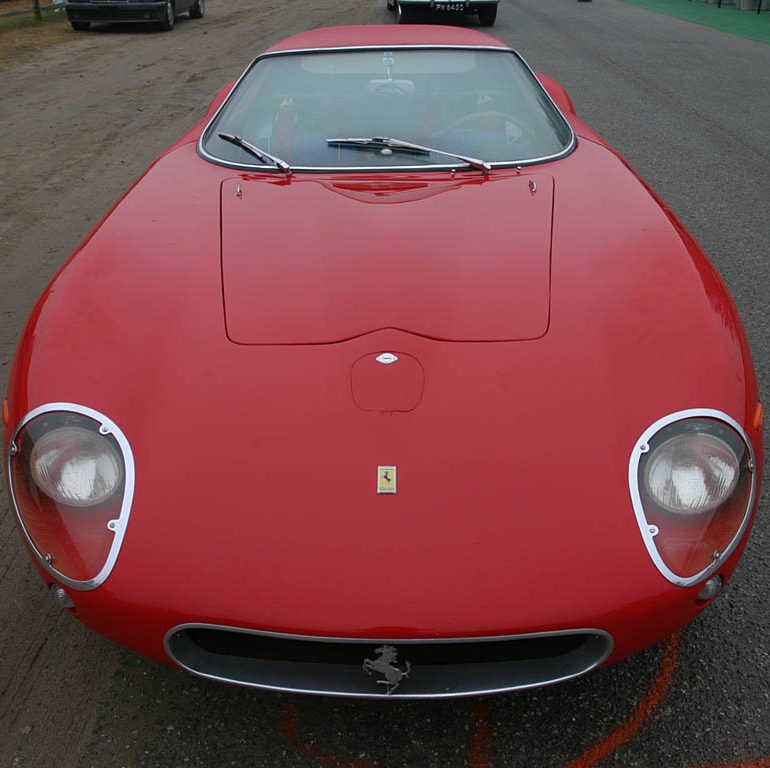1964 Ferrari 250 GTO ’64
The first GTO was completed in 1962, having a body sculpted in-house and later revised by Scaglietti. In 1963 steps were made to improve the car, which included an all-new, Pininfarina-designed body. Sometimes referred to as the Series II or ’64 GTO, only three examples originally received the new body. These were chassis #5571GT, 5573GT and #5575GT. Their bodies were radically different from the previous GTOs, reflecting the style of the upcoming 250 LM.
Chassis & Engine
For the 1964 race season, Ferrari was prepared to use their mid-engined 250 LM in Division III of GT endurance racing. Unfortunately the FIA rejected homologation for the 250 LM, forcing Ferrari to revert to the GTO. Revisions were necessary to the car to keep it competitive.
As homologation stated, the 1964 GTO chassis had to remain the same as the first design. So, mechanically speaking, the ’64 GTO was very similar to the ’62/’63 cars. The only chassis modification adopted by the FIA, was a wider track, brought forth by using wider wheels.
The engine for the ’64 GTO retained the familiar Tipo 168/62 V12. Slight modifications included different tuning for the Weber carburetors and smaller exhaust manifolds. Such modifications did not improve peak power, but widened the overall power band.
Pininfarina’s Body
After being forced to use the GTO, Ferrari had the body re-engineered by Pininfarina and produced by Scaglietti. The new Pininfarina design was both lower and wider than the original GTO. While this may have improved handling, the shortened frontal area caused more drag than the original GTO.
See full 1964 Ferrari 250 GTO ’64 Gallery here
As with the early GTOs, different devices made each ’64 GTO unique. As an example chassis #5571GT had an airfoil atop its roof while all other ’64 GTOs had a rounded edge. One especially interesting development was the use of rammed, cold air induction on chassis #5573GT and #5575GT for the 1964 LeMans. Previously, all other GTOs used unforced, warm air-induction.
1964 Race Season
Stiff competition came in 1964 from Shelby with the Cobra Daytona Coupe and Jaguar with the Lightweight E-Type. Continually, Shelby would hold the fastest lap times around various courses, but it was reliability that would plague the American team. Like the year before, Ferrari dominated the GT class in 1964, taking class wins at most of the 15 races during the season. Outright victories were taken by GTOs at Daytona and the SPA 500 kms.
The 1964 LeMans saw an especially heated battle between Shelby and Ferrari for the GT class. Four GTOs entered the event, all aimed at beating Shelby’s Daytona Coupe. The result was outstanding for Ferrari, taking the overall victory with their Ferrari 275P, but the GTOs were unable to beat the Cobras and missed the GT victory.
Shelby, with his Cobra, proved the GTO was reaching the end of its racing career in 1964. Ferrari unable to homologate the 250 LM, withdrew from GT racing. This left the ’64 GTO to mark the end of the 250-series racing berlinettas which began in 1954. After ten years of complete dominance in the field, the 250 series left a string of serial success that will be hard to match for decades to come.
Photo Gallery
We have included a few images here, but don’t forget to check out the full 1964 Ferrari 250 GTO ’64 Gallery.
Ferrari 250 GTO ’64 (Series II) Specs & Performance
| type | Racing Car |
| built at | Maranello, Italy |
| body stylist | Pininfarina |
| production | 6 |
| predeccesor | 1962 Ferrari 250 GTO |
| succeccesor | 1984 Ferrari 288 GTO |
| engine | Tipo 168/62, 60 Degree V12 |
| position | Front Longitudinal |
| aspiration | Natural |
| valvetrain | SOHC 2 Valves / Cyl |
| fuel feed | 6 Webber-38 DCN Carburettors |
| displacement | 2953 cc / 180.2 in³ |
| bore | 73 mm / 2.87 in |
| stroke | 58.8 mm / 2.31 in |
| compression | 9.7:1 |
| power | 223.7 kw / 300.0 bhp @ 7700 rpm |
| specific output | 101.59 bhp per litre |
| bhp/weight | 272.73 bhp per tonne |
| torque | 292.86 nm / 216 ft lbs @ 5500 rpm |
| redline | 8500 |
| body / frame | Aluminum Body over Steel Frame |
| driven wheels | RWD w/ZF Limited Slip |
| front tires | 600lx15 |
| rear tires | 600lx15 |
| front brakes | Dunlop Discs w/Hydrualic Assist |
| rear brakes | Dunlop Discs w/Hydrualic Assist |
| front wheels | F 38.1 x 16.5 cm / 15 x 6.5 in |
| rear wheels | R 38.1 x 19.0 cm / 15 x 7.5 in |
| steering | ZF Wom & Peg |
| f suspension | Double Wishbones w/Coil Springs, Koni Adjustable Shock Absorbers, 16.5mm Anti-Roll Bar |
| r suspension | Live Axle w/Semi-Elliptic Springs, Koni Shock Aborbers, Dual Watts Linkage |
| curb weight | 1100 kg / 2425 lbs |
| front track | 1445 mm / 56.9 in |
| rear track | 1414 mm / 55.7 in |
| length | 4300 mm / 169.3 in |
| width | 1760 mm / 69.3 in |
| height | 1140 mm / 44.9 in |
| transmission | Porsche 5-Speed Manual |
| top speed | ~254 kph / 157.8 mph |
| 0 – 60 mph | ~6.1 seconds |
| 0 – 100 mph | ~13.1 seconds |
| 0 – 1/4 mile | ~13.5 seconds |







